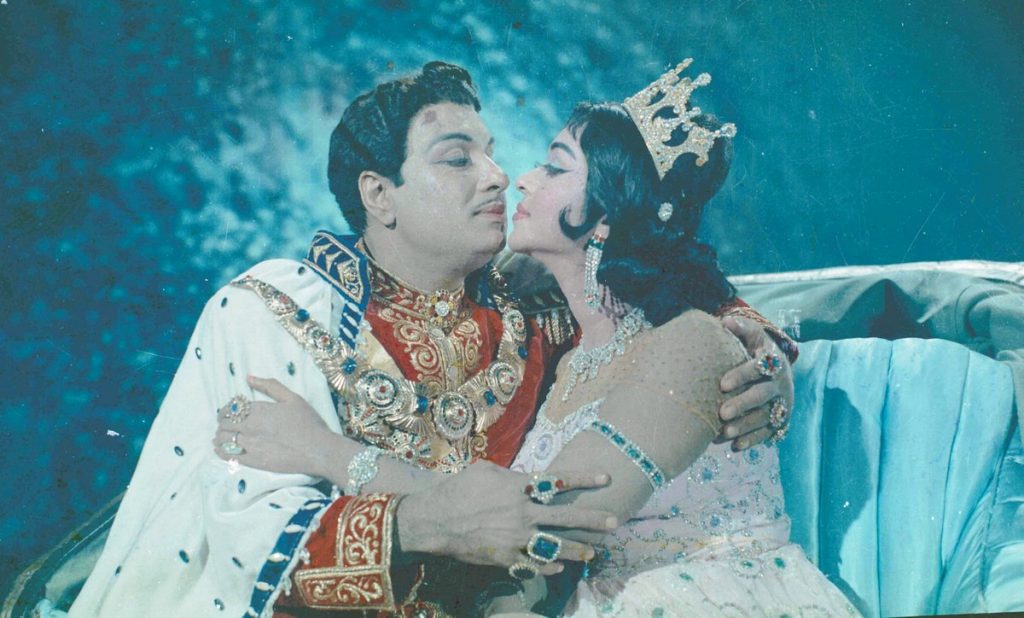It was the release of Nadodi Mannan on August 22nd, 1958 that first brought MG Ramachandran (MGR) and B Saroja Devi together as a lead pair in the eyes of the Tamil cinema going audiences. The film, produced and directed by MGR himself, is a loose take off from two Ronald Colman films, The Prisoner Of Zenda (1937) and If I Were King (1938), with MGR playing the dual roles of the king and the vagabond and P Bhanumathi and Saroja Devi playing the leading ladies. It led to a scintillating screen-partnership between MGR and Saroja Devi that lasted through 26 films, many of them hugely successful. Their pairing ended finally with Arasa Kattalai (1967).
Initially, the pair took some time to get going. In spite of Nadodi Mannan‘s mammoth success, celebrated publicly by the DMK party to whom MGR was affiliated to, the pair surprisingly had no follow up films for the whole of 1959 and 1960 and that too in an Industry where a success is sort to be duplicated as soon as possible. But then slowly and surely, the blitz began. And when it did, it was virtually unstoppable. 1961 saw two of their films release, 1962 another four, 1963 yet another four, 1964 saw five, 1965 three, 1966 all of six, before finally ending with a solitary release in 1967.
Some prominent films of the MGR-Saroja Devi pairing include Thaai Sollai Thattadhe (1961), Thirudadhe (1961), Paasam (1962) – the one relative failure, where it is said fans couldn’t digest MGR’s death in the film, Periya Idathu Penn (1963), Padakotti (1964), Enga Veetu Pillai (1965), Naan Aanaiyittal (1966), Nadodi (1966), Parakkum Paavai (1966) and MGR’s only film for AVM, Anbe Vaa (1966).
The two complemented each other beautifully. Their films were largely socials where MGR generally played the savior of the oppressed and the poor and the ideal man, and Saroja Devi, more often than not, enacted the role of the perfect ‘Indian woman’ for him to take home to. Which meant she followed his word, supported him in all his endeavors, hardly ever showed skin, never wore sleeveless clothes, be it sari blouses, tops, dresses or gowns. She was usually draped in gorgeous saris, making her quite the fashion icon for Tamil women of the time. On screen, the two shared an easy and likeable camaraderie and this showed as they seemed extremely comfortable playing off each other, giving and taking in equal measure. Their romantic songs, in particular, proved to be highly popular and are fondly recalled and hummed by old timers even today.
Incidentally, there was an additional film, Adimai Penn (1968), where Saroja Devi was signed on to co-star with MGR and she even did some shooting for the film before she was replaced by J Jayalalithaa. It is said that one of the main reasons MGR decided to change his Adimai Penn heroine was because she had got married in 1967 and in those days, it was thought that a heroine lost her allure for audiences post marriage. Never mind that in a male dominated industry, MGR was already 50 and had been married thrice, while Saroja Devi was just 29 at the time. Incidentally, Jayalalithaa had also clamored with Saroja Devi for MGR’s attention in Arasa Kattalai. So in that sense between Arasa Kattalai and Adimai Penn, it was more like a passing of the baton from Saroja Devi to Jayalalithaa for becoming MGR’s favorite heroine or ‘muse’.
Jayalalithaa and MGR too became a much loved screen pair and worked together in some 28 films but more of that another time.


